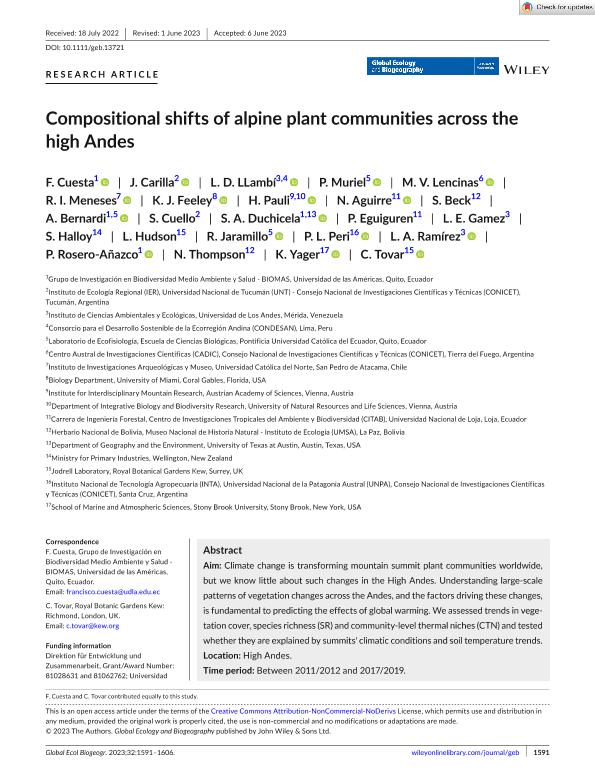Artículo
Compositional shifts of alpine plant communities across the high Andes
Cuesta, F.; Carilla, Julieta ; LLambí, L. D.; Muriel, P.; Lencinas, María Vanessa
; LLambí, L. D.; Muriel, P.; Lencinas, María Vanessa ; Meneses, R. I.; Feeley, K. J.; Pauli, H.; Aguirre, N.; Beck, S.; Bernardi, A.; Cuello, S.; Duchicela, S. A.; Eguiguren, P.; Gamez, L. E.; Halloy, S.; Hudson, L.; Jaramillo, R.; Peri, Pablo Luis
; Meneses, R. I.; Feeley, K. J.; Pauli, H.; Aguirre, N.; Beck, S.; Bernardi, A.; Cuello, S.; Duchicela, S. A.; Eguiguren, P.; Gamez, L. E.; Halloy, S.; Hudson, L.; Jaramillo, R.; Peri, Pablo Luis ; Ramírez, L .A.; Rosero Añazco, P.; Thompson, N.; Yager, K.; Tovar, C.
; Ramírez, L .A.; Rosero Añazco, P.; Thompson, N.; Yager, K.; Tovar, C.
 ; LLambí, L. D.; Muriel, P.; Lencinas, María Vanessa
; LLambí, L. D.; Muriel, P.; Lencinas, María Vanessa ; Meneses, R. I.; Feeley, K. J.; Pauli, H.; Aguirre, N.; Beck, S.; Bernardi, A.; Cuello, S.; Duchicela, S. A.; Eguiguren, P.; Gamez, L. E.; Halloy, S.; Hudson, L.; Jaramillo, R.; Peri, Pablo Luis
; Meneses, R. I.; Feeley, K. J.; Pauli, H.; Aguirre, N.; Beck, S.; Bernardi, A.; Cuello, S.; Duchicela, S. A.; Eguiguren, P.; Gamez, L. E.; Halloy, S.; Hudson, L.; Jaramillo, R.; Peri, Pablo Luis ; Ramírez, L .A.; Rosero Añazco, P.; Thompson, N.; Yager, K.; Tovar, C.
; Ramírez, L .A.; Rosero Añazco, P.; Thompson, N.; Yager, K.; Tovar, C.
Fecha de publicación:
08/2023
Editorial:
Wiley Blackwell Publishing, Inc
Revista:
Global Ecology and Biogeography
ISSN:
1466-822X
Idioma:
Inglés
Tipo de recurso:
Artículo publicado
Clasificación temática:
Resumen
Climate change is transforming mountain summit plant communities worldwide,but we know little about such changes in the High Andes. Understanding large-scale patterns of vegetation changes across the Andes, and the factors driving these changes, is fundamental to predicting the effects of global warming. We assessed trends in vegetation cover, species richness (SR) and community-level thermal niches (CTN) and tested whether they are explained by summits´ climatic conditions and soil temperature trends. Using permanent vegetation plots placed on 45 mountain summits and soil temperature loggers situated along a ~6800 km N-S gradient, we measured species and their relative percentage cover and estimated CTN in two surveys (intervals between 5 and 8 years). We then estimated the annual rate of changes for the three variables and used generalized linear models to assess their relationship with annual precipitation, the minimum air temperatures of each summit and rates of change in the locally recorded soil temperatures. Over time, there was an average loss of vegetation cover (mean = −0.26%/yr), and a gain in SR across summits (mean = 0.38 species m2/yr), but most summits had significant increases in SR and vegetation cover. Changes in SR were positively related to minimum air temperature and soil temperature rate of change. Most plant communities experienced shifts in their composition by including greater abundances of species with broader thermal niches and higher optima. However, the measured changes in soil temperature did not explain the observed changes in CTN. Main conclusions: High Andean vegetation is changing in cover and SR and is shifting towards species with wider thermal niche breadths. The weak relationship with soil temperature trends could have resulted from the short study period that only marginally captures changes in vegetation through time.
Archivos asociados
Licencia
Identificadores
Colecciones
Articulos(IER)
Articulos de INSTITUTO DE ECOLOGIA REGIONAL
Articulos de INSTITUTO DE ECOLOGIA REGIONAL
Articulos(SEDE CENTRAL)
Articulos de SEDE CENTRAL
Articulos de SEDE CENTRAL
Citación
Cuesta, F.; Carilla, Julieta; LLambí, L. D.; Muriel, P.; Lencinas, María Vanessa; et al.; Compositional shifts of alpine plant communities across the high Andes; Wiley Blackwell Publishing, Inc; Global Ecology and Biogeography; 32; 9; 8-2023; 1591-1606
Compartir
Altmétricas



